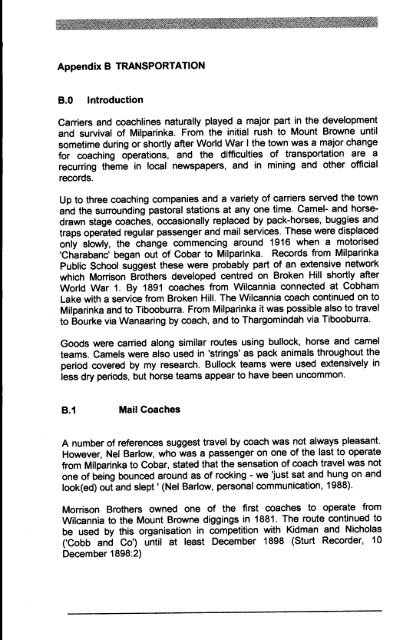Adec Preview Generated PDF File - The Sydney eScholarship ...
Adec Preview Generated PDF File - The Sydney eScholarship ...
Adec Preview Generated PDF File - The Sydney eScholarship ...
You also want an ePaper? Increase the reach of your titles
YUMPU automatically turns print PDFs into web optimized ePapers that Google loves.
Appendix B TRANSPORTATION<br />
B.O Introduction<br />
Carriers and coachlines naturally played a major part in the development<br />
and survival of Milparinka. From the initial rush to Mount Browne until<br />
sometime during or shortly after World War I the town was a major change<br />
for coaching operations, and the difficulties of transportation are a<br />
recurring theme in local newspapers, and in mining and other official<br />
records.<br />
Up to three coaching companies and a variety of carriers served the town<br />
and the surrounding pastoral stations at anyone time. Camel- and horsedrawn<br />
stage coaches, occasionally replaced by pack-horses, buggies and<br />
traps operated regular passenger and mail services. <strong>The</strong>se were displaced<br />
only slowly, the change commencing around 1916 when a motorised<br />
'Charabanc' began out of Cobar to Milparinka. Records from Milparinka<br />
Public School suggest these were probably part of an extensive network<br />
which Morrison Brothers developed centred on Broken Hill shortly after<br />
World War 1. By 1891 coaches from Wilcannia connected at Cobham<br />
Lake with a service from Broken Hill. <strong>The</strong> Wilcannia coach continued on to<br />
Milparinka and to Tibooburra. From Milparinka it was possible also to travel<br />
to Bourke via Wanaaring by coach, and to Thargomindah via Tibooburra.<br />
Goods were carried along similar routes using bullock, horse and camel<br />
teams. Camels were also used in 'strings' as pack animals throughout the<br />
period covered by my research. Bullock teams were used extensively in<br />
less dry periods, but horse teams appear to have been uncommon.<br />
B.1 Mail Coaches<br />
A number of references suggest travel by coach was not always pleasant.<br />
However, Ne! Barlow, who was a passenger on one of the last to operate<br />
from Milparinka to Cobar, stated that the sensation of coach travel was not<br />
one of being bounced around as of rocking - we 'just sat and hung on and<br />
look(ed) out and slept' (Nel Barlow, personal communication, 1988).<br />
Morrison Brothers owned one of the first coaches to operate from<br />
Wilcannia to the Mount Browne diggings in 1881. <strong>The</strong> route continued to<br />
be used by this organisation in competition with Kidman and Nicholas<br />
('Cobb and Co') until at least December 1898 (Sturt Recorder, 10<br />
December 1898:2)




